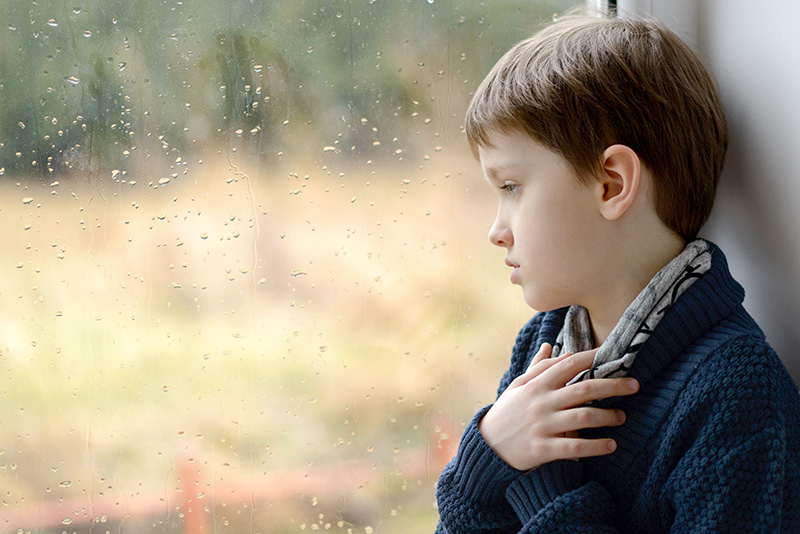Challenging behavior is common among individuals with autism spectrum disorder (ASD). Challenging behavior includes tantrums, self-injurious behavior, noncompliance, and aggression, especially when they occur with heightened intensity or frequency (Machalicek et al., 2016). In addition, anxiety and depression occur at high rates among autistic individuals (Gotham et al., 2015). Though often overlooked, anxiety and depression may contribute to the presentation of challenging behavior. Failing to identify mental health problems in the context of challenging behavior may result in ineffective treatment and negatively affect long-term functioning.

Research indicates a relationship between mental health problems and challenging behavior among autistic individuals. Associations between anxiety and challenging behavior have been observed across a range of ages and cognitive abilities (Bitsika & Sharpley, 2016; Cervantes et al., 2013; Rzepecka et al., 2011; Moskowitz et al., 2013). Anxiety has also been linked to specific challenging behaviors, including aggression (Ambler et al., 2015; Hill et al., 2014) and self-injury (Oliver et al., 2017; Soke et al., 2017). Challenging behavior may also indicate underlying depression. Autistic individuals who are depressed may display increased aggression, self-injurious behavior, and behavior problems (Baudewijns et al., 2018; Soke et al., 2017). In particular, marked changes in the frequency or intensity of challenging behavior can be an important marker of depression, particularly for individuals who do not communicate verbally (Magnuson & Constantino, 2011).
A recent study at the Center for Autism in Albany, NY suggests that disruptive behavior is a more important predictor of anxious and depressive symptoms for autistic youth than youth with similar cognitive and adaptive functioning. Youth receiving comprehensive autism diagnostic evaluations reported their anxiety, mood, and disruptive behavior symptoms. Disruptive behavior accounted for significantly more variance in anxiety and depressive symptoms among autistic youth (n = 68) compared to those without ASD (n = 42), indicating stronger associations between disruptive behavior and mental health problems within ASD. Additionally, disruptive behavior was a more important predictor than other correlates of psychopathology, including cognitive ability and self-esteem. These results, in combination with existing research, suggest anxiety and depression should be evaluated in the context of challenging behavior, particularly among autistic populations.

Kristin V. Christodulu, PhD

Emma Wilkinson, BA
Due to associations between behavior problems, anxiety, and depression, autistic individuals with challenging behavior should be routinely screened for co-occurring mental health problems. Assessment of anxiety and depression can be difficult in autistic populations, therefore multi-modal (observation, questionnaires, interviews) and multi-informant (self, caregiver, teacher) assessment is recommended (Hagopian & Jennett, 2014; Moskowitz et al., 2013). Furthermore, screening should occur regardless of the individual’s age, cognitive ability, or preconceptions about the cause of the behavior. Screening for these co-occurring mental health problems can help professionals and clinicians working with autistic individuals rule out potential co-occurring issues and develop appropriate interventions.
Special care should be taken during functional behavioral assessments to determine if anxiety or depression are present. With anxiety, it can be difficult to determine whether behaviors are due to general dislike of a situation or context or because that situation is anxiety-provoking to the individual (Hagopian & Jennett, 2014; Moskowitz et al., 2017). If anxiety is missed, behaviors may be misunderstood as noncompliance or defiance, affecting intervention choices and subsequent improvement.
Finally, if anxiety and depression are present, professionals may want to incorporate specific strategies into challenging behavior treatment (Kildahl et al., 2020; Moskowitz et al., 2017). Because cognitive-behavioral therapy (CBT) effectively reduces anxiety and depression in individuals with ASD (e.g., Kerns et al., 2016), CBT strategies, such as graduated exposure, increasing positive activities, and coping strategies, may be particularly useful. Overall, consideration of anxiety and depression when assessing and treating challenging behavior is recommended to help professionals provide appropriate interventions and targeted care for individuals on the autism spectrum.
Emma Wilkinson, BA, is a Graduate Assistant at the University at Albany Center for Autism and Related Disabilities. Kristin V. Christodulu, PhD, is Director at the University at Albany Center for Autism and Related Disabilities. For more information, contact Emma Wilkinson at ewilkinson2@albany.edu.
References
Ambler, P. G., Eidels, A., & Gregory, C. (2015). Anxiety and aggression in adolescents with au-tism spectrum disorders attending mainstream schools. Research in Autism Spectrum Disorders, 18, 97–109. https://doi.org/10.1016/j.rasd.2015.07.005
Baudewijns, L., Ronsse, E., Verstraete, V., Sabbe, B., Morrens, M., & Bertelli, M. O. (2018). Problem behaviours and major depressive disorder in adults with intellectual disability and au-tism. Psychiatry Research, 270, 769–774. https://doi.org/10.1016/j.psychres.2018.10.039
Bitsika, V., & Sharpley, C. F. (2016). Which aspects of challenging behaviour are associated with anxiety across two age groups of young males with an autism spectrum disorder? Journal of De-velopmental and Physical Disabilities, 28(5), 685–701. https://doi.org/10.1007/s10882-016-9502-4
Cervantes, P., Matson, J. L., Tureck, K., & Adams, H. L. (2013). The relationship of comorbid anxiety symptom severity and challenging behaviors in infants and toddlers with autism spectrum disorder. Research in Autism Spectrum Disorders, 7(12), 1528–1534. https://doi.org/10.1016/j.rasd.2013.09.005
Gotham, K., Brunwasser, S. M., & Lord, C. (2015). Depressive and anxiety symptom trajectories from school age through young adulthood in samples with autism spectrum disorder and devel-opmental delay. Journal of the American Academy of Child and Adolescent Psychiatry, 54(5), 369-376.e3. https://doi.org/10.1016/j.jaac.2015.02.005
Hagopian, L., & Jennett, H. (2014). Behavioral assessment and treatment for anxiety for those with autism spectrum disorder. In T. E. Davis III, S. W. White, & T. H. Ollendick (Eds.), Hand-book of Autism and Anxiety (pp. 155–169). Springer International Publishing. https://doi.org/10.1007/978-3-319-06796-4_11
Hill, A. P., Zuckerman, K. E., Hagen, A. D., Kriz, D. J., Duvall, S. W., van Santen, J., Nigg, J., Fair, D., & Fombonne, E. (2014). Aggressive behavior problems in children with autism spectrum disorders: Prevalence and correlates in a large clinical sample. Research in Autism Spectrum Dis-orders, 8(9), 1121–1133. https://doi.org/10.1016/j.rasd.2014.05.006
Kerns, C. M., Roux, A. M., Connell, J. E., & Shattuck, P. T. (2016). Adapting cognitive behav-ioral techniques to address anxiety and depression in cognitively able emerging adults on the au-tism spectrum. Emerging Adulthood: Developmental and Clinical Considerations in Developing Efficacious Interventions for College-Aged Populations, 23(3), 329–340. https://doi.org/10.1016/j.cbpra.2016.06.002
Kildahl, A. N., Bakken, T. L., Matre, E. A. W., Hellerud, J. M. A., Engebretsen, M. H., & Helv-erschou, S. B. (2020). Case study: Identification of anxiety and subsequent intervention in an adolescent male with autism, severe intellectual disability and self-injurious behaviour. Interna-tional Journal of Developmental Disabilities, 0(0), 1–12. https://doi.org/10.1080/20473869.2020.1850160
Machalicek, W., Raulston, T., Knowles, C., Ruppert, T., Carnett, A., & Alresheed, F. (2016). Challenging Behavior. In J. L. Matson (Ed.), Comorbid conditions among children with autism spectrum disorders (pp. 137–170). Springer International Publishing. https://doi.org/10.1007/978-3-319-19183-6_6
Magnuson, K. M., & Constantino, J. N. (2011). Characterization of depression in children with autism spectrum disorders. Journal of Developmental and Behavioral Pediatrics : JDBP, 32(4), 332–340. https://doi.org/10.1097/DBP.0b013e318213f56c
Moskowitz, L. J., Mulder, E., Walsh, C. E., McLaughlin, D. M., Zarcone, J. R., Proudfit, G. H., & Carr, E. G. (2013). A multimethod assessment of anxiety and problem behavior in children with autism spectrum disorders and intellectual disability. American Journal on Intellectual and Developmental Disabilities, 118(6), 419–434. https://doi.org/10.1352/1944.7558.118.6.419
Moskowitz, L. J., Walsh, C. E., Mulder, E., McLaughlin, D. M., Hajcak, G., Carr, E. G., & Zar-cone, J. R. (2017). Intervention for anxiety and problem behavior in children with autism spec-trum disorder and intellectual disability. Journal of Autism and Developmental Disorders, 47(12), 3930–3948. https://doi.org/10.1007/s10803-017-3070-z
Oliver, C., Licence, L., & Richards, C. (2017). Self-injurious behavior in people with intellectual disability and autism spectrum disorder. Current Opinion in Psychiatry, 30(2), 97–101. https://doi.org/10.1097/YCO.0000000000000313
Rzepecka, H., McKenzie, K., McClure, I., & Murphy, S. (2011). Sleep, anxiety and challenging behavior in children with intellectual disability and/or autism spectrum disorder. Research in De-velopmental Disabilities, 32(6), 2758–2766. https://doi.org/10.1016/j.ridd.2011.05.034
Soke, G. N., Rosenberg, S. A., Hamman, R. F., Fingerlin, T., Rosenberg, C. R., Carpenter, L., Lee, L. C., Giarelli, E., Wiggins, L. D., Durkin, M. S., Reynolds, A., & DiGuiseppi, C. (2017). Factors associated with self-injurious behaviors in children with autism spectrum disorder: Find-ings from two large national samples. Journal of Autism and Developmental Disorders, 47(2), 285–296. https://doi.org/10.1007/s10803-016-2951-x





